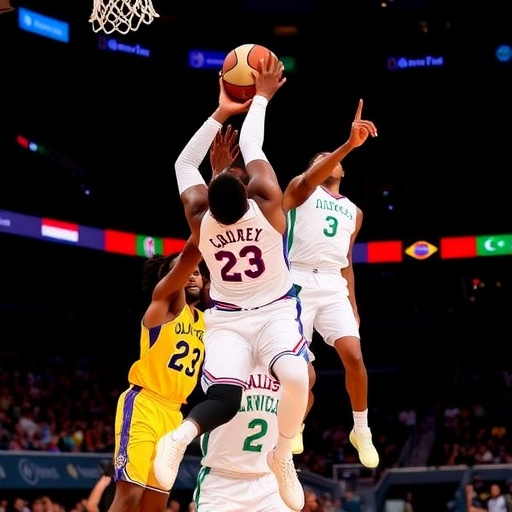NBA Shatters Records: 135 International Players from 43 Countries Kick Off 2025-26 Season
In a groundbreaking display of global talent, the NBA has set a new benchmark for diversity as opening night rosters for the 2025-26 season feature a record 135 international players hailing from 43 different countries. This surge underscores the league’s evolution into a truly worldwide phenomenon, with stars like Giannis Antetokounmpo leading the charge and Canada emerging as the unexpected frontrunner in international representation.
The announcement, made just hours before tip-off of the new season, highlights how the NBA‘s commitment to scouting and developing talent beyond U.S. borders has paid off spectacularly. Last season’s count of 120 international players pales in comparison, marking this as a 12.5% increase that reflects broader trends in basketball’s globalization. From the high-stakes drama of opening night games to the cultural fusion on the court, this record-breaking diversity promises to infuse the league with fresh narratives and competitive fire.
Commissioner Adam Silver celebrated the milestone in a pre-season press conference, stating, “The NBA has always been about bringing the best talent to the table, and tonight, we’re witnessing the most diverse opening night in our history. These players aren’t just representing their countries; they’re redefining basketball on a global scale.” This sentiment echoes the league’s strategic push, including initiatives like the Basketball Without Borders program, which has funneled young prospects from around the world into NBA pipelines.
Canada Surges Ahead with 17 International Breakouts
At the forefront of this international wave is Canada, boasting an impressive 17 players on opening night rosters—a jump from 13 last year and solidifying its position as the leading source of non-U.S. talent. This Canadian dominance is no fluke; it’s the result of a robust developmental ecosystem that includes elite youth programs, university leagues, and a passionate fanbase that rivals any in North America.
Key figures like Jamal Murray of the Denver Nuggets and Andrew Wiggins of the Golden State Warriors have paved the way, but the 2025-26 class introduces fresh faces such as Vancouver’s rising star, Olivier-Maxence Prosper, who earned a spot with the Dallas Mavericks after a stellar Summer League performance. Prosper, a 6’7″ forward with a versatile skill set, embodies the new generation of Canadian athletes blending athleticism with basketball IQ honed in competitive environments like the Canadian Elite Basketball League (CEBL).
Statistics paint a vivid picture: Of Canada’s 17 representatives, eight are guards, six forwards, and three centers, showcasing a balanced attack that addresses various team needs. Toronto Raptors president Masai Ujiri, himself a Nigerian-born executive, commented on the trend, saying, “Canada’s basketball revolution is real. We’re not just producing players; we’re creating a culture that exports excellence to the NBA.” This influx has also boosted viewership in the Great White North, with NBA games drawing record TV ratings north of the border.
Beyond the numbers, the Canadian story adds emotional depth. Players like Shai Gilgeous-Alexander of the Oklahoma City Thunder have become national heroes, inspiring a new wave of kids in cities like Toronto and Montreal to dream big. The diversity within Canada’s contingent—spanning French-speaking Quebec to Indigenous communities—further enriches the NBA’s tapestry, proving that international players bring not just skills but unique perspectives.
Giannis Antetokounmpo Anchors a Galaxy of Global Superstars
No discussion of the NBA’s international record is complete without spotlighting Giannis Antetokounmpo, the Milwaukee Bucks’ Greek-Nigerian phenom whose journey from Athens streets to NBA Finals MVP has become legendary. As one of 11 Greek players in the league, Antetokounmpo remains the beacon for international aspirations, his two MVP awards and 2021 championship ring symbolizing the heights achievable by global talent.
This season, Antetokounmpo is joined by a constellation of stars that amplify the record’s impact. France contributes 12 players, including Rudy Gobert of the Minnesota Timberwolves, whose defensive prowess has earned him four Defensive Player of the Year honors. Australia’s Patty Mills, now with the Miami Heat, adds veteran leadership with his sharpshooting and Olympic pedigree, while Serbia’s Nikola Jokić, the Denver Nuggets’ triple-double machine and back-to-back MVP, continues to dazzle with his playmaking genius.
The list of luminaries extends further: Germany’s Dennis Schröder brings tenacity to the Brooklyn Nets, and Nigeria’s Precious Achiuwa fortifies the New York Knicks’ frontcourt. Antetokounmpo himself reflected on the milestone during Bucks media day, noting, “Seeing so many brothers from different countries on the same stage motivates me. The NBA isn’t American basketball anymore—it’s world basketball, and that’s beautiful.” His words capture the camaraderie among international players, who often form tight-knit groups off the court, sharing meals and traditions that foster team chemistry.
Quantitatively, these stars elevate the league’s metrics: International players accounted for 28% of All-Star selections last season, a figure expected to rise with this deepened roster. Their influence extends to endorsements, too—Antetokounmpo’s Nike deal alone rivals top Americans, proving that global appeal translates to business success.
Mapping the World: Talent Hotspots from Europe to Asia
The 135 international players span 43 countries, creating a virtual atlas of basketball excellence that stretches from Europe’s storied courts to Asia’s emerging arenas. Europe remains the powerhouse with 72 players, led by France (12), Serbia (8), and Spain (7), where La Liga ACB has long served as a breeding ground for NBA prospects.
Africa’s representation has grown to 14 players, with Nigeria and Cameroon each contributing three, highlighting the continent’s untapped potential through programs like the NBA Africa initiative. South Sudan’s Bol Bol, a 7’3″ center for the Phoenix Suns, exemplifies this rise, his journey from refugee camps to the pros inspiring millions. In Asia, Japan’s Rui Hachimura of the Los Angeles Lakers anchors a group of five, while China’s Yao Ming legacy endures with Zhou Qi’s return to the Houston Rockets.
Latin America adds flair with Brazil’s Bruno Caboclo and Argentina’s Luis Scola-inspired talents, totaling nine players who bring samba rhythms and tango precision to the hardwood. Even smaller nations shine: Lithuania’s Domantas Sabonis dominates for the Sacramento Kings, and Slovenia’s Luka Dončić, the Dallas Mavericks’ wunderkind, continues to rewrite record books at age 26.
This geographic spread isn’t accidental. The NBA’s global academies in Senegal and India, coupled with international drafts, have democratized access. Data from the league shows that 40% of these players entered via the G League or overseas pro leagues, underscoring a merit-based system that rewards skill over geography. As one scout put it, “The world is our scouting ground now—every corner has a diamond in the rough.”
- Europe: 72 players, dominant in skill development.
- Africa: 14 players, rapid growth via NBA Africa.
- Asia: 12 players, bridging East-West basketball styles.
- Latin America: 9 players, infusing passion and creativity.
- Oceania: 8 players, led by Australia’s athletic exports.
Such distribution enhances on-court dynamics, with hybrid styles—think Jokić’s European finesse meeting Antetokounmpo’s African athleticism—leading to innovative plays that captivate fans worldwide.
Diversity Drives NBA’s Explosive Global Growth
The record number of international players is more than a statistic; it’s the engine propelling the NBA’s diversity forward, translating to packed arenas overseas and skyrocketing streaming numbers. In 2024, international NBA viewership hit 1.2 billion, a 15% year-over-year increase attributed to relatable stars from fans’ home countries.
Off the court, this diversity fosters inclusivity. Initiatives like the NBA’s Crossover program pair international players with local charities, amplifying social impact. For instance, Antetokounmpo’s foundation in Greece supports youth sports, while Canadian players advocate for mental health awareness amid hockey’s shadow.
Economically, the benefits are clear: Merchandise sales in Europe surged 25% last year, driven by player-specific jerseys. The league’s partnerships with entities like the International Basketball Federation (FIBA) ensure sustained pipelines, with the 2024 Olympics showcasing NBA talent and boosting recruitment.
Challenges persist—visa issues and cultural adjustments test rookies—but success stories abound. Take France’s Bilal Coulibaly, whose Washington Wizards tenure has bridged NBA and European styles seamlessly. As diversity deepens, it enriches storytelling, from multilingual press conferences to global All-Star weekends.
Charting the Course: How This Milestone Shapes Basketball’s Tomorrow
Looking ahead, this record-setting opening night signals an irreversible shift toward a borderless NBA. With 135 international players setting the tone, expect intensified global scouting, more bilingual broadcasts, and expanded academies in untapped markets like the Middle East.
Projections suggest the 2026-27 season could see 150-plus internationals, as youth programs in countries like the Philippines and South Africa mature. Antetokounmpo envisions a future where “every kid, anywhere, sees themselves in the NBA.” For teams, it means diversified rosters yielding championships—witness the international-heavy Boston Celtics’ 2024 title run.
The ripple effects extend to fans: Enhanced rivalries, like Canada vs. USA exhibitions, and cultural exchanges will deepen engagement. As Silver noted, “This is just the beginning. Diversity isn’t a goal; it’s our reality, driving innovation and unity.” With the season underway, all eyes are on how these global ambassadors will redefine competition, inspiring the next generation to lace up and chase their NBA dreams.










